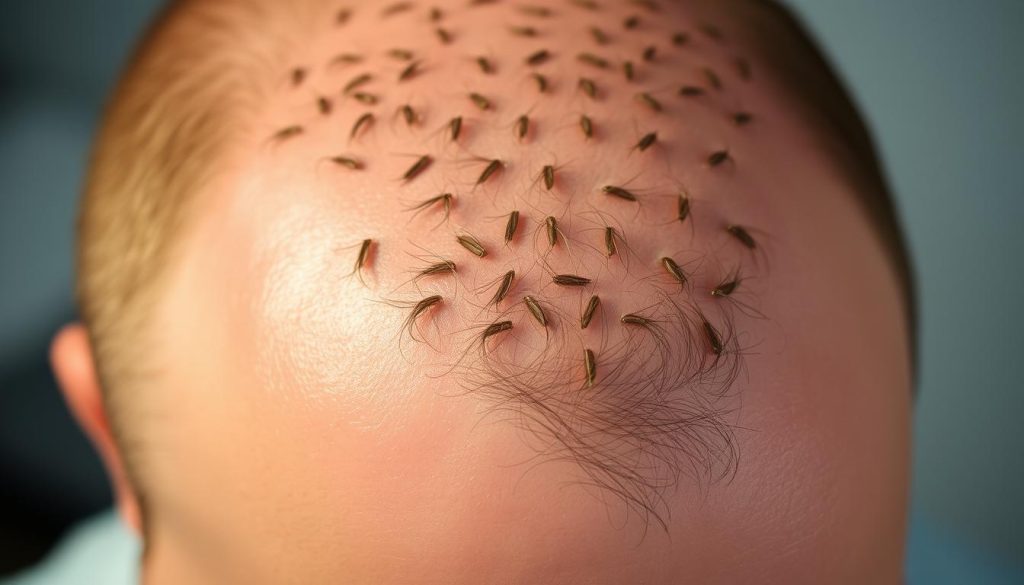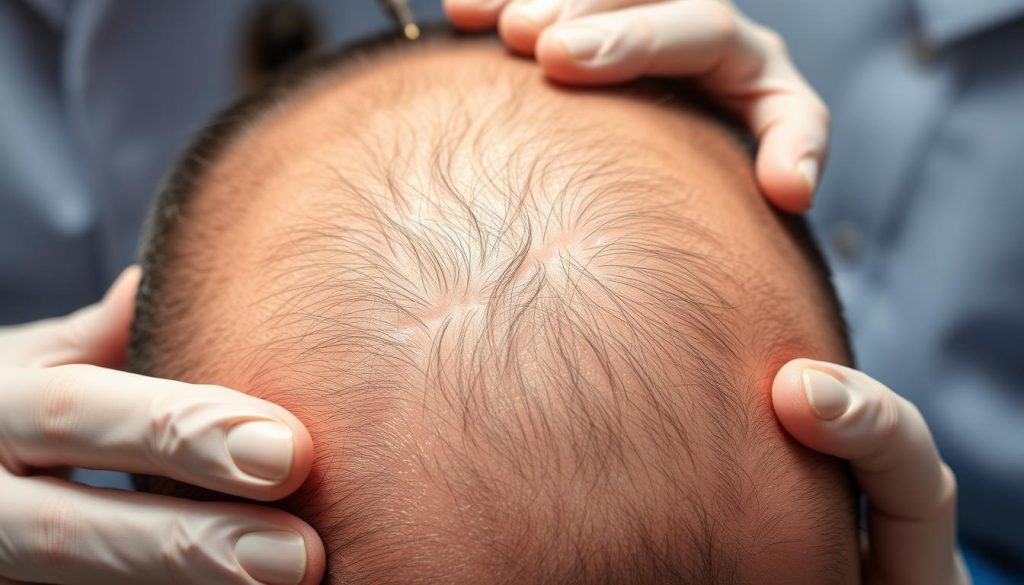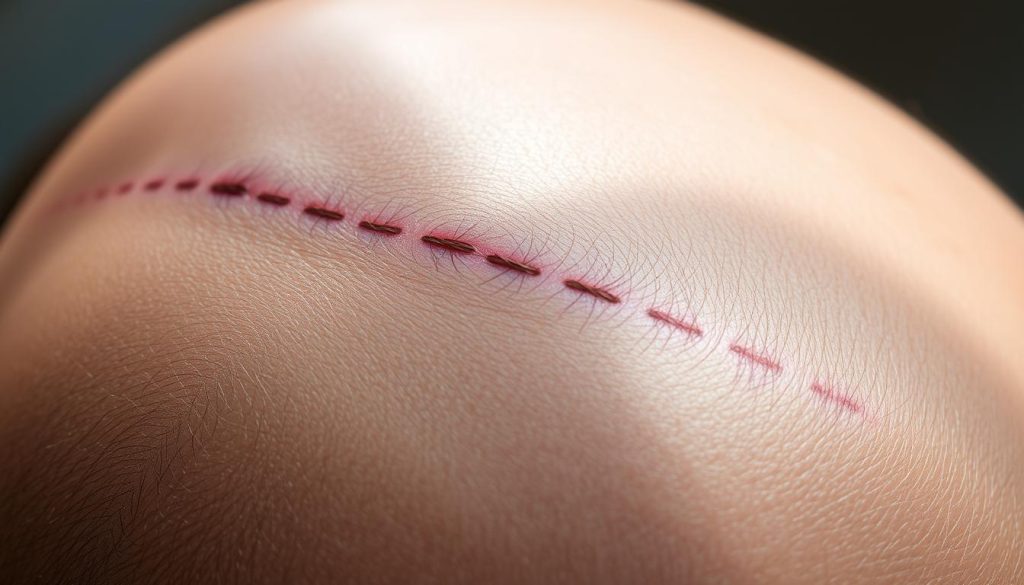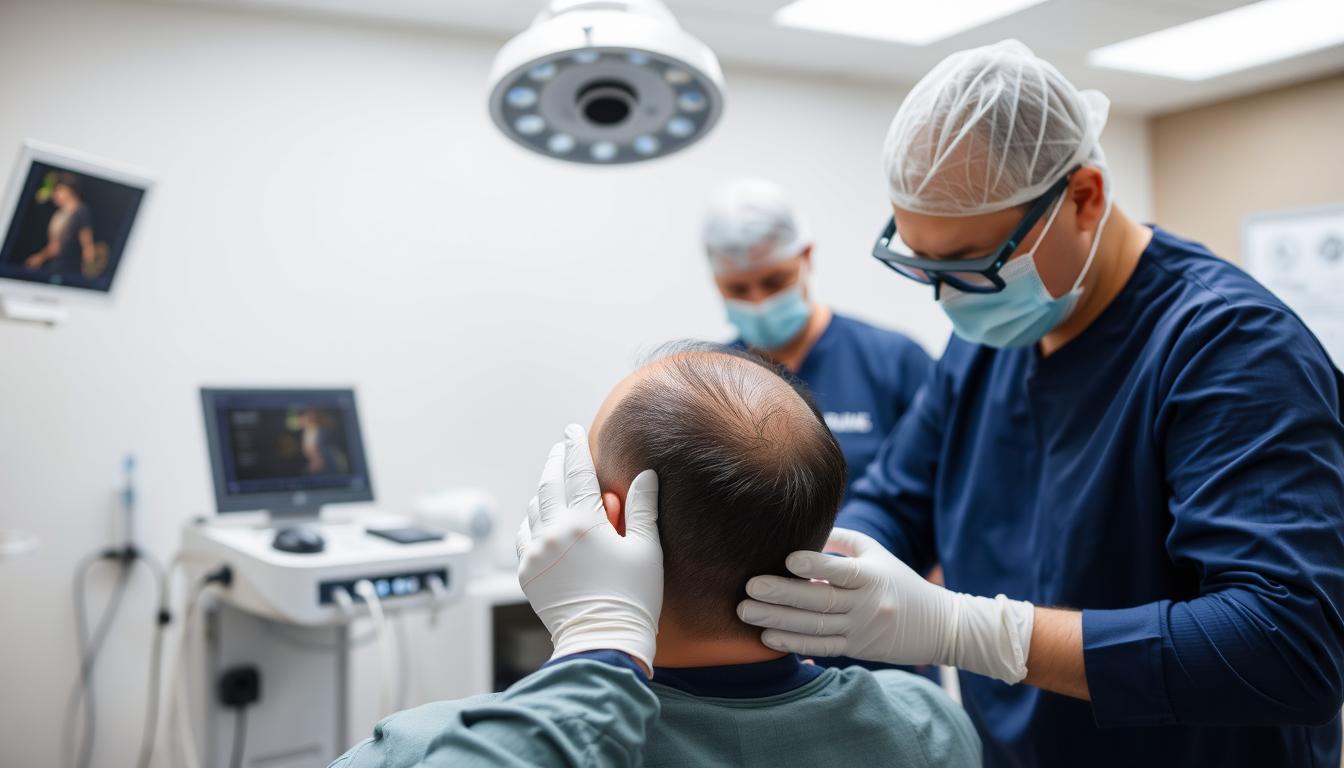Understanding FUT Hair Transplant
FUT hair transplant procedures have revolutionized the field of hair restoration. Hair loss affects up to 85 percent of men and 40 percent of women, making it a significant concern for many. Follicular Unit Transplantation (FUT) is a minimally invasive surgery designed to help cover bald spots caused by hair loss.
The history of hair transplants dates back to at least 1939 in Japan. However, it wasn’t until surgeons began transplanting individual hair follicles in 1995 that hair transplants started giving natural-looking results. This technique has evolved significantly, now offering results that can dramatically improve appearance and confidence.
The FUT hair transplant process involves several key steps, including harvesting a strip of hair-bearing tissue from the donor area, typically the back of the head, and transplanting individual follicular units to areas experiencing thinning or baldness.
- FUT hair transplant (Follicular Unit Transplantation) represents one of the most established and effective solutions for addressing hair loss in both men and women.
- This procedure involves harvesting a strip of hair-bearing tissue from the donor area and transplanting individual follicular units to areas experiencing thinning or baldness.
- The technique has evolved significantly, now offering natural-looking results that can dramatically improve appearance and confidence.
- Understanding the complete process, from initial consultation to recovery, is essential for anyone considering this hair restoration option.
- This comprehensive guide will explore all aspects of FUT hair transplants, including the procedure details, benefits, costs, and how it compares to alternative treatments.
By choosing FUT hair transplant, individuals can achieve significant hair restoration results. It’s crucial to understand the procedure, its benefits, and the associated costs to make an informed decision.
Understanding FUT Hair Transplant
Follicular Unit Transplantation (FUT) is a revolutionary hair restoration technique that has transformed the field of hair transplantation. It involves transplanting hair follicles from the donor area to the balding regions, resulting in natural-looking hair growth.
What is Follicular Unit Transplantation?
Follicular Unit Transplantation (FUT) is a surgical procedure where a strip of hair-bearing scalp is removed from the back and sides of the head. The strip is then dissected into individual follicular units, which are transplanted into the recipient sites. This technique allows for the transplantation of a large number of grafts in a single session, making it an efficient hair restoration method.
History and Development of FUT
Hair transplants date back to at least 1939 in Japan, but early results often looked unnatural. The modern FUT technique emerged in the 1990s, with significant advancements occurring since then. Key milestones include the publication of research by Dr. Robert Bernstein and Dr. William Rassman on follicular unit transplantation, which transformed the field.
| Year | Milestone |
|---|---|
| 1939 | First recorded hair transplants in Japan |
| 1990s | Emergence of Follicular Unit Transplantation (FUT) |
| 1995 | Transplanting individual hair follicles became common, leading to more natural results |

The FUT Hair Transplant Procedure Step by Step
The process of FUT hair transplantation is intricate, involving careful planning and execution. It begins with a thorough examination of the patient’s scalp to determine the best course of action for hair transplantation.
Pre-Surgery Preparation
Before the surgery, the patient is prepared for the procedure, which includes administering local anesthesia to minimize discomfort. The donor area is then prepared for the removal of a strip of tissue containing hair follicles.
The Strip Removal Process
The surgeon removes a strip of tissue from the donor area, which is then examined to harvest hair follicles for grafting. Technicians count each graft to ensure enough healthy hair follicles are extracted to achieve the desired hairline and cover the treatment area.
Graft Preparation and Implantation
After the strip removal, technicians dissect it into individual follicular units, which are then prepared for implantation. The surgeon creates recipient sites in the balding areas and delicately places the prepared grafts into these sites, ensuring a natural appearance and optimal growth.
The entire process requires precision, as each graft must be placed at a specific depth and angle. This meticulous process can take several hours, depending on the number of grafts being transplanted.
Benefits of Choosing FUT Hair Transplant
FUT hair transplant has become a sought-after solution for hair loss due to its effectiveness. This method offers several advantages that make it an attractive option for individuals considering hair restoration.
Higher Graft Yield and Density
One of the primary benefits of FUT is its ability to yield a higher number of grafts. This results in a more dense hair restoration, which is particularly beneficial for individuals with extensive hair loss. The strip harvesting technique used in FUT allows surgeons to extract a large number of grafts quickly, making it an efficient hair transplant method.

Time and Cost Efficiency
FUT surgery is generally quicker than alternative methods like FUE, with most sessions completed in 4-8 hours. The reduced operating time translates to lower overall costs, making FUT a more affordable option for many patients. Some key benefits include:
- Reduced surgical time compared to FUE
- Lower overall costs for comparable graft numbers
- Efficient strip harvesting technique for quick graft extraction
- Cost-effective solution for patients requiring extensive coverage
By choosing FUT hair transplant, patients can achieve their desired restoration goals while minimizing their investment of time and money.
FUT vs. FUE: Understanding Your Options
When considering hair restoration, understanding the differences between FUT and FUE hair transplants is crucial. Both techniques have their advantages and are suited to different patient needs.
Key Differences in Technique
The primary difference between FUT and FUE lies in how hair follicles are extracted. FUT involves removing a strip of hair-bearing skin from the donor area, whereas FUE involves extracting individual follicular units directly from the donor site. FUT may be more suitable for patients requiring a large number of grafts, as it allows for a higher yield in a single session. On the other hand, FUE is preferred for its minimally invasive nature and the ability to harvest hair from other body parts.
Comparing Recovery and Results
Recovery from FUT typically involves a longer healing period and more discomfort due to the linear incision. In contrast, FUE patients usually experience quicker recovery times and less pain. However, the final hair growth results from both procedures are comparable when performed by skilled surgeons. A comparison of the two procedures is summarized in the table below:
| Procedure | Recovery Time | Scarring | Cost |
|---|---|---|---|
| FUT | 2-3 weeks | Linear scar | Generally cheaper |
| FUE | 7-10 days | Tiny, less noticeable scars | Can be more expensive |
Ideal Candidates for FUT Hair Transplant
Determining the ideal candidate for FUT hair transplant involves several key factors. The procedure is not suitable for everyone experiencing hair loss, and a thorough evaluation is necessary to determine candidacy.
Age and Hair Loss Patterns
Age and hair loss patterns play a significant role in determining suitability for FUT. Ideal candidates are typically those with stable hair loss patterns and sufficient donor hair. Generally, individuals with advanced hair loss who have a significant amount of hair in the donor area are good candidates.
Hair Characteristics and Donor Area Quality
Hair characteristics, such as thickness, texture, and curl pattern, significantly impact transplant results. The quality of the donor area is paramount, with ideal candidates possessing good hair density in the permanent zone at the back and sides of the scalp. The contrast between hair color and scalp color also affects the visual density of results.
Candidates should have sufficient donor hair reserves to address both current and potential future hair loss. Scalp laxity is another important consideration, as adequate flexibility in the scalp tissue allows for easier closure of the donor area with minimal tension.
Recovery and Aftercare Following FUT
Recovery and aftercare are vital components of the FUT hair transplant process, directly impacting the success of the surgery. Proper care following the procedure ensures optimal healing and results.
Immediate Post-Procedure Care
Immediately after the FUT hair transplant, patients should focus on gentle care to promote healing. This includes avoiding strenuous activities and protecting the donor area from tension for about a month. Hair transplant aftercare also involves shielding the head from direct sunlight for several months to prevent damage.
Long-Term Healing Process
The long-term healing process involves several phases. Initially, patients may experience “shock loss,” where transplanted hair falls out within two to four weeks. However, this is typically followed by new hair growth beginning around three to four months post-procedure. Significant improvements become visible at six to eight months, with final results apparent by 12 to 18 months.
| Healing Phase | Timeline | Description |
|---|---|---|
| Shock Loss | 2-4 weeks | Transplanted hair falls out |
| New Hair Growth | 3-4 months | Initial signs of hair regrowth |
| Significant Improvement | 6-8 months | Visible enhancements in hair density |
| Final Results | 12-18 months | Complete outcome of the hair transplant |
Throughout the recovery period, it’s crucial to follow the surgeon’s recommendations regarding post-operative care, including the use of specialized shampoos and hair care products. Protecting both the donor and recipient areas from direct sun exposure is also vital. The linear scar in the donor area will mature over 6-12 months, becoming less noticeable over time.
Potential Side Effects and Considerations
As with any surgical procedure, FUT hair transplant comes with its own set of possible complications. While serious issues are rare, understanding the potential risks is crucial for patients considering this hair restoration method.
Understanding FUT Scarring
One of the primary concerns with FUT hair transplant is scarring. The procedure involves removing a strip of hair-bearing skin from the back of the head, which can result in a linear scar. However, skilled surgeons use techniques to minimize the visibility of this scar. Proper post-operative care can also help in reducing the appearance of scarring.

Other Possible Complications
Other potential complications, though rare, can include infection, folliculitis (inflammation of the hair follicles), and temporary numbness. The risk of infection is less than 1% due to the scalp’s rich blood supply. Patients may experience some swelling, pain, or numbness post-surgery, but these effects typically resolve within a few months.
| Complication | Frequency | Resolution |
|---|---|---|
| Infection | <1% | Antibiotics |
| Folliculitis | Rare | Topical/Oral Antibiotics |
| Numbness | Common | 2-8 months |
FUT Hair Transplant Cost Factors
The cost of FUT hair transplant procedures can vary significantly based on several factors. Understanding these elements is crucial for individuals considering hair restoration.
Average Price Range in the United States
The average cost of a FUT hair transplant in the United States can range widely, typically between $3,000 to $15,000 or more, depending on the extent of the procedure and the clinic’s reputation. Highly experienced surgeons often charge premium rates, reflecting their expertise and the quality of results. Patients should also consider additional expenses such as travel and accommodation if they need to visit a clinic in another city.
What Influences the Final Cost
Several key factors influence the final cost of a FUT hair transplant. These include:
- The number of grafts being transplanted, with clinics typically charging per graft.
- The surgeon’s experience and reputation, with more skilled surgeons commanding higher fees.
- The location of the clinic, as major cities often have higher prices.
- Additional services such as PRP therapy or specialized aftercare packages.
These factors can significantly impact the overall cost of hair restoration, making it essential for patients to consult with their chosen clinic to understand the total investment required.
Making an Informed Decision About Hair Restoration
Achieving a natural-looking hairline through hair restoration is a goal for many, and FUT hair transplant can be an effective way to get there. When considering hair restoration options, it’s essential to weigh the benefits and drawbacks of each method.
Patients should consider their long-term hair loss pattern, lifestyle factors, and aesthetic goals when choosing between FUT and other hair transplant options. Selecting a surgeon who specializes in hair restoration is crucial, as their experience significantly impacts the naturalness of results.
By reviewing before-and-after photos and speaking with former patients, prospective patients can gain a better understanding of what to expect. Ultimately, the decision to undergo FUT hair transplant should balance medical considerations, aesthetic goals, and personal preferences to achieve the most satisfying outcome.
FAQ
What is the difference between Follicular Unit Transplantation (FUT) and Follicular Unit Extraction (FUE)?
FUT involves removing a strip of scalp from the donor area, whereas FUE involves extracting individual follicular units directly from the donor area.
How long does it take to recover from a FUT procedure?
The recovery time for FUT typically ranges from 7 to 14 days, during which patients may experience some discomfort, swelling, and scarring.
Will I have a noticeable scar after FUT surgery?
The scar from FUT is usually linear and located at the back of the head, but it can be minimized with proper surgical technique and post-operative care.
Can women undergo FUT hair restoration?
Yes, women can be good candidates for FUT, especially those with sufficient donor area density and suitable hair characteristics.
How is the cost of FUT determined?
The cost of FUT is influenced by factors such as the number of grafts required, the surgeon’s fees, and the location where the procedure is performed.
What are the benefits of choosing FUT over FUE?
FUT offers a higher graft yield and density, making it a more efficient option for those requiring a large number of grafts.
Is FUT a painful procedure?
Patients typically receive local anesthesia during FUT, minimizing discomfort during the procedure. Some pain and discomfort may be experienced during the recovery period.
How long do the results of FUT last?
The results of FUT are generally long-lasting, as the transplanted follicles are resistant to balding and will continue to grow naturally.
